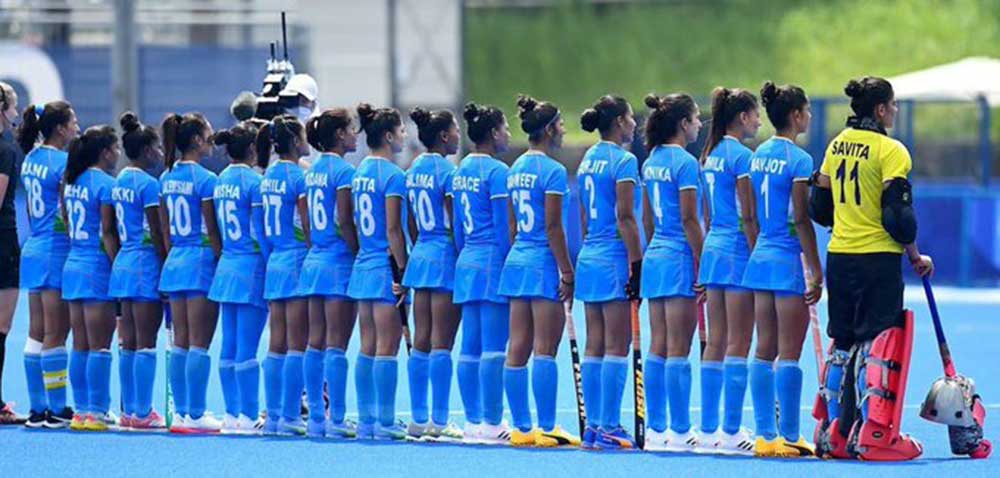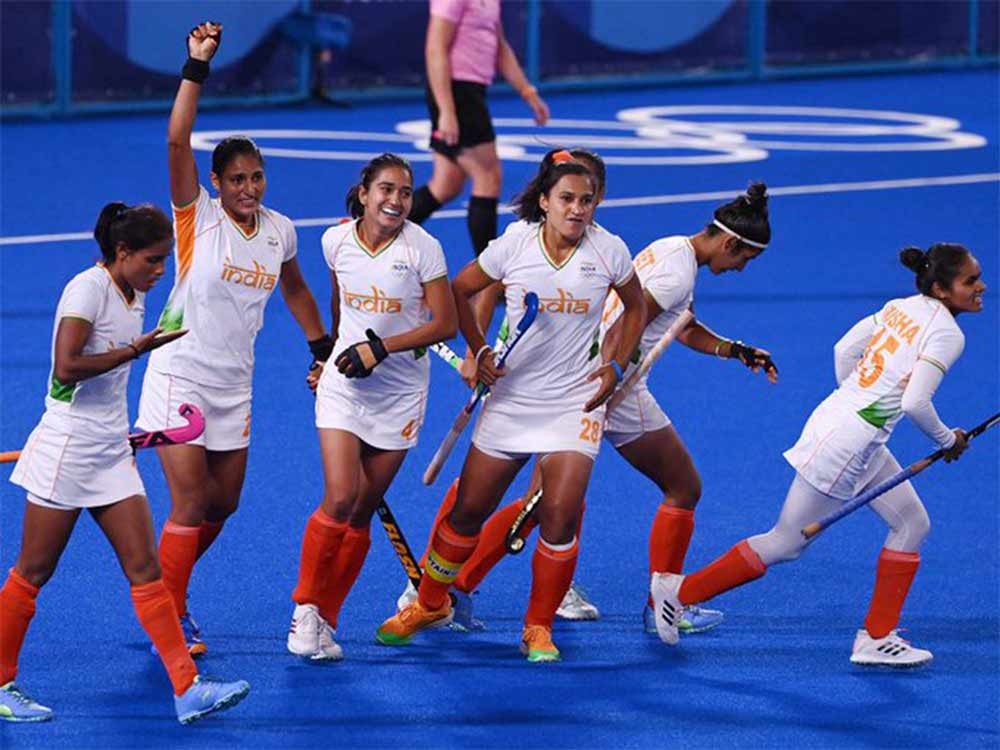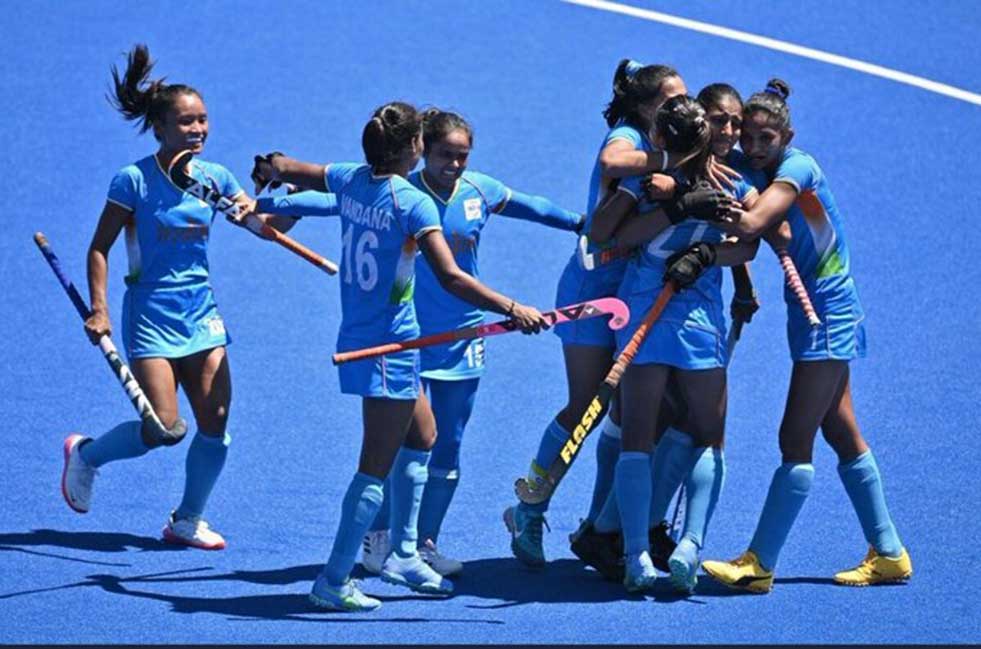Hockey, India’s national game, has a storied history in the country and the world. On the one hand, this nation has produced stalwarts like Dhyan Chand and a long line of male hockey players who have brought international glory and accolades home. On the other hand, Indian women hockey players have also made quite the mark over the last two decades. In 2021, the Indian women’s hockey team proved beyond a doubt that they may not have been around since the moment the game was introduced in the country, but they sure are on the way to winning glory for the nation. Here’s all you need to know.
Hockey In India
The first hockey club was formed in Kolkata in 1855 by the British. Since then, the game was popularised in the provinces of Bombay (now Maharashtra and Gujarat) and Punjab. The International Hockey Federation (FIH) was formed in 1924, and in the following year, the Indian Hockey Federation (IHF) was established. In 1926, the Indian men’s hockey team went on its first tour, to New Zealand, where the team played 21 matches and won 18 of those. This tournament saw the rise of Dhyan Chand, who was the greatest hockey player in Indian history—and arguably the best hockey player in the world.
The Indian men’s team participated in its first Olympics in 1928, and has since then left a huge legacy. But the women weren’t going to be left far behind. The Indian women’s hockey team was formed after independence, and they got their breakthrough moment in 1974 at the Women’s Hockey World Cup at Mandelieu, where it finished fourth. Since then, the team has only gone from strength to strength over the decades.
Past Performances Of Indian Women’s Hockey Team
Perhaps the best performance of the Indian women’s hockey team came at the 1980 Olympic Games, where the team finished in fourth place, narrowly missing out on the bronze medal. In 1982, the team won the Asian Games, bagging the gold medal by beating the Korean team at the finals. This win was made possible by the brilliant team led by Suraj Lata Devi. Under Devi’s leadership, this particular team managed to win the gold medal for three consecutive years at different international games: the 2002 Commonwealth Games, the 2003 Afro-Asian Games, and the 2004 Women’s Hockey Asia Cup.
Due to their brilliant win in 2004, the team came to be known as the “Golden Girls of Hockey”. Their 2002 victory on the other hand, inspired the movie Chak De! India, which popularised women’s hockey across the length and breadth of the entire country. The national team continued their streak at the 2013 Women’s Hockey Asia Cup at Kuala Lumpur by bagging the third place. They finished fifth at the 2014 Commonwealth Games, but at the 2014 Asian Games, they beat Japan to win the bronze medal. In 2016, the team qualified for the Rio Olympic Games for the first time since 1980. They were eliminated early, however, and finished last.
The team’s latest victory comes with the 2020 Tokyo Olympic Games, which got postponed to 2021 due to the COVID-19 pandemic. For the first time, the women’s team made India proud by reaching the semi-finals. While the team couldn’t clinch the medal at the semi-finals, and lost out on the bronze medal, they still brought immense glory to the game and the nation.

Current Indian Women’s Hockey Team
The current Indian women’s hockey team is headed by captain Rani Rampal. The following are all the details of the team you need to know.
Rani Rampal, Captain/Forward: The key player and captain of the team, this 26-year-old from Haryana made her hockey debut at the age of 14, and has played a vital role in winning international glory for the team and country throughout her professional life. Experts believe she was one of the chief reasons why Team India qualified for the Tokyo Olympics.
Savita Punia, Vice-Captain/Goalkeeper: With two Asian Games medals to her name, Punia is one of the star players of the team—as a goalkeeper should indeed be. Carrying a goalie’s equipment, especially during the heat of the game, can be quite difficult, but Punia manages it with panache. The fact that she was applauded for her role in the victory against Australia in the quarterfinals proves it.
Neha Goyal, Midfielder: This might be Goyal’s first time at the Olympics, but this 24-year-old has never been one to let the odds or obstacles stop her. Known for her scorching pace and goal scoring abilities, Goyal has the title of Hockey India Midfielder of the Year, and a silver medal at the Asian Games, under her belt.
Nikki Pradhan, Defender: Pradhan hails from Jharkhand, and a family that has overcome financial troubles to play hockey. She got her first pair of professional hockey stick and shoes when she got the chance to play for an academy in Ranchi in 2006. From there on, the rise of this player has been significant. She made her Olympic debut in Rio 2016, and has played a prominent role in India’s victories at Tokyo too.
Nisha Warsi, Midfielder: Making her international debut only two years ago, partially owing to the fact that she had to take a break to support her family when her father had a paralytic attack in 2015. Warsi made her comeback to the game after his recovery, and took three years to get a place in the national team in 2018. Since then, this 26-year-old has been unstoppable.
Lalremsiami, Forward: Better known as Siami, this 21-year-old player from Mizoram is the reason why the Indian team manages to play high-tempo hockey at international tournaments. Mentored by Rani Rampal, Siami made history as the first female player from her state to make it to the Olympics. Her rise in the team and the game has never been hindered by the fact that Siami could speak neither English nor Hindi when she first made it to the team.
Sushila Chanu, Midfielder: In the last decade, Chanu has emerged as one of the most experienced and influential hockey players in India. She captained the team at the Rio Olympics, and has played her part for the team and country at Asian Games and Commonwealth Games. Instrumental in India’s wins at Tokyo, Chanu has over 150 caps to her name and works for the Indian Railways in Mumbai.
Deep Grace Ekka, Defender: Hailing from Lulkidihi, Odisha, Ekka was criticised in her small town for not doing her chores at home. Her family, which has also produced a former Indian goalkeeper for the men’s team, supported her hockey dreams—which helped her be a part of the national team that won the Asian Cup in 2017. This is her second stint at the Olympics, and she has over 200 caps to her name.
Salima Tete, Midfielder: Born in a Naxal stringhold in Jharkhand, which is also known for hockey enthusiasts, Tete worked in her family’s farm to be able to earn money to buy a hockey stick. One of the youngest players on the team at 19, Tete already has 29 caps to her name. Here’s hoping this young and rising player scores more during her Olympic stint.
Udita Duhan, Defender: Duhan’s introduction to hockey was purely by chance, as she was priming to pursue handball instead. A twist of fate at school, and her mother’s support, helped Duhan switch to hockey. Her rise in the game has been as quick as her playing speed since, and she even captained the Under-18 Hockey team that won the bronze medal at the Asian Cup, 2016. Since 2017, Duhan has been a fixture in the senior women’s team, and her contribution to the team’s high-paced game has been marked.
Vandana Katariya, Forward: The only Indian woman player to score a hat-trick at the Olympics, Katariya’s game during the Tokyo Games has been at a high point. This, despite the fact that she lost her father just a few months ago, and couldn’t attend the funeral. Given her father had been her main source of support against societal pressures, this loss must have been felt heavily indeed.
Navneet Kaur, Forward: One of the eight players from the current team that also competed at Rio, Kaur has been one of India’s most consistent forwards. Her series of incredible performances began with the Junior World Cup, 2013, where the Indian team won a bronze. Expectations from this 25-year-old have been high throughout the Tokyo Games, and she hasn’t disappointed one bit.
Monika Malik, Midfielder: This 27-year-old from Sonepat, Haryana, started her hockey training in Chandigarh, and even holds a business administration degree from Kurukshetra University. Often lauded as the Indian national team’s backbone, Malik has helped her team win the Asian Cup in 2018, a bronze at the Asian Games in 2014, and a silver at the Asian Games in 2018.
Gurjit Kaur, Defender: This 25-year-old scored the first goal against Argentina during the semi-finals at the Tokyo Olympics. Her goal against Australia during the quarter-finals won hearts, but this wasn’t the first time Kaur stole the show. She scored eight goals at the Asia Cup, 2017, and was the top scorer when India won the FIH Women’s Series in 2019.
Sharmila Devi, Forward: This 19-year-old from Haryana made her Olympic debut only this year, but has already left an indelible mark. On the scoresheet when India managed to qualify for the Tokyo Games, Devi has performed consistently throughout.
Navjot Kaur, Midfielder: It was with the encouragement of her father that Kaur started her hockey training in 2003. Inducted into the national team in 2012, Kaur has been its mainstay and contributed by her innate ability to poach goals while playing midfield—a remarkable feat indeed. This is her second time at the Olympic Games, but Kaur already has experience playing internationally, having played at the Asian Games in 2014 and 2018, and the World Cup in 2018.

Performance Of The Indian Hockey Team At Tokyo Olympics
In 2019, the Indian women’s hockey team defeated the United States’ team at the playoffs held at Bhubaneshwar for the FIH Olympic Qualifiers. This win secured the spot at the 2020 Tokyo Olympics for them. The Games were held in 2021, where the team progressed through the knockout levels swiftly. The team played their first match against the Netherlands, and was defeated 5-1. They played their next against Germany, and lost the match by 2-0. Playing against Great Britain next, the Indian team lost by 4-1.
After this series of initial defeats came a spate of victories. Team India won the match against Ireland by 1-0, their match against South Africa by 4-3, and their match against world champions Australia by 1-0. With this, they made history and entered the semi-finals, where they went head to head with Argentina. They lost this match by a narrow margin, ending the scores at 2-1, and yet made everyone proud through their performance. Team India then went toe to toe with Great Britain to see which team wins the bronze medal, and lost by 4-3. Despite this, the team managed to deliver a unique performance throughout the 2020 Olympics.
Why This Performance Was Extraordinary
The Indian women’s hockey team’s performance at the Tokyo Olympics was remarkable and truly inspiring for a number of reasons. Here are a few:
• The team managed to make history despite being unable to win a medal. This shows that you don’t necessarily need to win a gold to make a mark. Consistent performance is enough to win glory for the nation.
• The COVID-19 pandemic threw off global sporting events, especially the Olympics, and this led to many players going off form. The Indian women’s hockey team proved that despite all the safety protocols that needed to be followed and isolating quarantine they had to experience, it was all worth it for the nation.
• One of the teammates, Lalremsiami from Mizoram, lost her father in the middle of the Olympic Games. The team coach and captain both told her that she has the permission to go home if she so wishes, and yet, Siami chose to stay put and continue with the games. Her reason? Her father had supported her dream to represent the nation, and he wouldn’t want her to leave this dream unfulfilled. Siami went on to play a key role in the team’s victories.

Top Performers At Tokyo Olympics
During the Tokyo Olympics, while the entire team played really well, there were a few players who made more of a mark through their performances. Here are a few you must know about.
Rani Rampal: Apart from leading the team so ably throughout the event, Rampal also scored the only goal the team managed against Argentina in their opening match.
Gurjit Kaur: Now famous as the defender whose remarkable goal won the team a place in the semi-finals, Kaur also has the most number of goals to her name throughout the Games. Apart from the winning goal she scored against Australia in the quarterfinals, she also scored the only one against Argentina in the semi-finals, and scored two against Great Britain in the bronze medal qualifier match.
Vandana Katariya: Tying with Kaur as the highest goal scorer at the Olympics, Katariya made history when she scored three goals against South Africa—making her the only Indian woman player to register a hat-trick at the Olympics. She scored her fourth goal against Great Britain in the bronze medal qualifier match.
Navneet Kaur, Sharmila Devi, Neha Goyal: Each of these players scored one goal each at the matches the team played at the Olympics. Sharmila Devi scored the goal against Great Britain, Kaur scored one against Ireland, and Goyal scored one against South Africa.
Savita Punia: The goalkeeper is the most important part of the team’s defence strategy, and Punia did not disappoint throughout her stint at the Tokyo Olympics. Her performance against Australia in the quarterfinals was exceptionally brilliant as she didn’t let the Hockeyroos score a single goal against team India.
How This Performance Changed Indian Women’s Hockey Team Image
The Indian women’s hockey team fought against all odds at the Tokyo Olympics this year, and proved once again that while they may not have bagged a medal this year, they are geared to win and bring glory to the nation. They have proved that they are in good form despite all the ravages of the COVID-19 pandemic, and can perform under the immense pressure created by a world which is now run by very different safety protocols than it did before. Their performance at the Tokyo Olympics did not change their image in the perception of millions of Indians. Instead, it reinforced the image that Chak De! India, a movie based on a previous Indian women’s hockey team, had created—a team of 16 powerful women who are united in their mission to bring glory to the country on an international arena. That is what the current Indian women’s hockey represents, and they are truly inspiring the way they are.
Conclusion
The Indian women’s hockey team first came to the fore in the 1970s and 1980s, making a mark with the wins they clinched at international events. The current Indian women’s hockey team, led by captain Rani Rampal, has shown beyond doubt that they are made of the same inspiring determination to win. Even though this team couldn’t win a medal at the Tokyo Olympics, they are gearing up for future tournaments and championships with immense gusto.